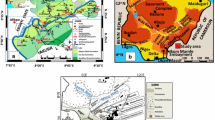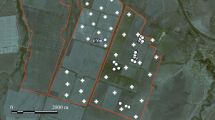Abstract
An in situ post tsunami study was conducted to assess the effect of water management and rainfalls in soil properties and water quality at a low-lying coastal area of central Chile affected by Mw8.8 Earthquake Tsunami the night of 27 February 2010. Soil samples were taken at two depths (0 to 20 and 20 to 40 cm) during 2010 and late 2012. Water quality in a local shallow well was also monitored in 2010 and 2012. High soil salinity was recorded 2 months later than tsunami occurs, closely associated to water-soluble chloride and cations (Cl− > > Na+ > > Ca2+ > Mg2+ > K+), ionic toxicities, and vegetal inhibition (Vasconcellea pubescens) by less available water to plants. An initial reduction in soil pH due to ionic strength and coarse-textured class of soil was observed and the sodium adsorption ratio (SAR) in soil varied between 5.7 and 11.2 (mmol L−1)0.5 showing to be saline. Although SARw values are very high (>18 (mmol L−1)0.5), it does not exist risks of reduction on soil infiltration rates according to ECw (>5 dS m−1) obtained. After 2 years, soil salinity was drastically reduced in the affected areas due to high soil permeability and natural attenuation (rainfalls and leaching effects), with sulfate and bicarbonate concentrations showing excessive values. Further, irrigation water quality returned to pre-tsunami situation, with only levels of sodium slightly exceeding desirable range from health point of view. Finally, it is suggested a proper design of irrigation systems before implementing other management practices.




Similar content being viewed by others
References
Agus, F., Rachman, A., Wahyunto, Ritung, S., McLeod, M., & Slavich, P. (2012). The dynamics of tsunami affected soil properties in Aceh, Indonesia. http://ir.library.tohoku.ac.jp/re/bitstream/10097/54435/1/AA12005506-2012-9-11.pdf. Accessed 27 July 2016.
Arslan, H., & Demir, Y. (2013). Impacts of seawater intrusion on soil salinity and alkalinity in Bafra Plain, Turkey. Environmental Monitoring and Assessment. doi:10.1007/s10661-012-2611-3.
Ayers, R. S., & Westcot, D. W. (1994). Water quality for agriculture, irrigation and drainage paper 29, rev. 1. Rome: Food and Agriculture Organization of the United Nations.
Bahlburg, H., & Weiss, R. (2007). Sedimentology of the December 26 (2004) Sumatra tsunami deposits in eastern India (Tamil Nadu) and Kenya. International Journal of Earth Sciences. doi:10.1007/s00531-006-0148-9.
Basile, A., Buttafuoco, G., Mele, G., & Tedeschi, A. (2012). Complementary techniques to assess physical properties of a fine soil irrigated with saline water. Environmental Earth Science. doi:10.1007/s12665-011-1404-2.
Carrasco, B., Ávila, P., Pérez-Díaz, J., Muñoz, P., García, R., Lavandero, B., et al. (2009). Genetic structure of highland papayas (Vasconcellea pubescens (Lennéet C. Koch) Badillo) cultivated along a geographic gradient in Chile as revealed by Inter Simple Sequence Repeats (ISRR). Genetic Resources and Crop Evolution. doi:10.1007/s10722-008-9367-1.
Casanova, M., Salazar, O., Seguel, O., & Luzio, W. (2013). The soils of Chile. Dordrecht: Springer.
Chagué-Goff, C., Niedzielski, P., Wong, H. K. Y., Szczuciński, W., Sugawara, D., & Goff, J. (2012). Environmental impact assessment of the 2011 Tohoku-oki tsunami on the Sendai Plain. Sedimentary Geology. doi:10.1016/j.sedgeo.2012.05.021.
Chappell, M., Middleton, M., & Price, C. (2013). Chemical and physical changes in tropical soils from seawater exposure and subsequent rainwater washes. Procedia Earth and Planetary Science. doi:10.1016/j.proeps.2013.03.190.
Chaudhary, D. R., Ghosh, A., & Patolia, J. S. (2006). Characterization of soils in the tsunami-affected coastal areas of Tamil Nadu for agronomic rehabilitation. Current Science, 91(1), 99–104.
Chesworth, W. (2008). Encyclopedia of soil science. Dordrecht: Springer.
Cisternas, M., Atwater, B. F., Torrejon, F., Sawai, Y., Machuca, G., Lagos, M., et al. (2005). Predecessors of the giant 1960 Chile earthquake. Nature. doi:10.1038/nature03943.
Farías, M., Vargas, G., Tassara, A., Carretier, S., Baize, S., Melnick, D., et al. (2010). Land level changes produced by the 2010 Mw 8.8 Chile earthquake. Science. doi:10.1126/science.1192094.
Francois, L. E., & Maas, E. V. (1999). Crop response and management on salt-affected soils. In M. Pessarakli (Ed.), Handbook of plant and crop stress (pp. 169–201). New York: Marcel Dekker Press Inc.
Hasanuzzaman, M., Kamrun, N., Alam, M. M., Bhowmik, P. C., Hossain, M. A., Rahman, M. M., et al. (2014). Potential use of halophytes to remediate saline soils. BioMed Research International. doi:10.1155/2014/589341.
Hazelton, P., & Murphy, B. (2007). Interpreting soil test results. What do all the numbers mean? Sidney: CSIRO Publishing.
Hulugalle, N. R., Jaya, R., Luther, G. C., Ferizal, M., Daud, S., Yatiman, et al. (2009). Physical properties of tsunami-affected soils in Aceh, Indonesia: 2½ years after the tsunami. Catena. doi:10.1016/j.catena.2009.01.001.
Jesus, J., Castro, F., Niemelä, A., Borges, M. T., Danko, A. S., et al. (2015). Evaluation of the impact of different soil salinization processes on organic and mineral soils. Water, Air & Soil Pollution. doi:10.1007/s11270-015-2373-y.
Khondaker, N. A., & Ozawa, K. (2007). Papaya plant growth as affected by soil air oxygen deficiency. Acta Horticulturae. doi:10.17660/ActaHortic.2007.740.27.
Kume, T., Umetsu, C., & Palani, K. (2009). Impact of the December 2004 tsunami on soil, groundwater and vegetation in the Nagapattinam district, India. Journal of Environmental Management. doi:10.1016/j.jenvman.2009.05.027.
Lu, S. G., Tang, C., & Rengel, Z. (2004). Combined effects of waterlogging and salinity on electrochemistry, water-soluble cations and water dispersible clay in soils with various salinity levels. Plant and Soil. doi:10.1023/B:PLSO.0000047748.50435.fc.
Marler, T. E. (2007). Papaya seed germination and seedling emergence are not influenced by solution pH. Acta Horticulturae. doi:10.17660/ActaHortic.2007.740.24.
Mastronuzzi, G., & Sansó, P. (2004). Large boulder accumulations by extreme waves along the Adriatic coast of southern Apulia (Italy). Quaternary International. doi:10.1016/j.quaint.2004.01.016.
McGrath, J. M., Spargo, J., & Penn, C. J. (2014). Soil fertility and plant nutrition. In N. K. Van Alfen (Ed.), Encyclopedia of agriculture and food systems (pp. 166–184). Oxford: Elsevier.
McLeod, M. K., Slavich, P. G., Irhas, Y., Moore, N., Rachman, A., Ali, N., et al. (2010). Soil salinity in Aceh after the December 2004 Indian Ocean tsunami. Agriculture Water Management. doi:10.1016/j.agwat.2009.10.014.
Montecinos, A., & Aceituno, P. (2003). Seasonality of the ENSO-related rainfall variability in Central Chile and associated circulation anomalies. Journal of Climate. doi:10.1175/1520-0442(2003)0162.0.CO;2.
Moqsud, M. A., & Omine, K. (2013). Bioremediation of agricultural land damaged by tsunami. In R. Chamy & F. Rosenkranz (Eds.), Biodegradation of hazardous and special products (pp. 39–50). Rijeka: Intech.
Morton, R. A., Gelfenbaum, G., Buckley, M. L., & Richmond, B. M. (2011). Geological effects and implications of the 2010 tsunami along the central coast of Chile. Sedimentary Geology. doi:10.1016/j.sedgeo.2011.09.004.
Nayak, A. K., Damodaran, T., Singh, C. S., Jha, S. K., Raja, D., Mishra, V. K., et al. (2010). Post tsunami changes in soil properties of Andaman Islands, India. Environmental Monitoring and Assessment. doi:10.1007/s10661-009-1225-x.
Oster, J. D., & Schroer, F. W. (1979). Infiltration as influenced by irrigation water quality. Soil Science Society of America Journal, 43, 444–447.
Peel, M. C., Finlayson, B. L., & McMahon, T. A. (2007). Updated world map of the Köppen–Geiger climate classification. Hydrology and Earth System Sciences Discussion. doi:10.5194/hess-11-1633-2007.
Pizarro, R., Valdés, R., García-Chevesich, P., Vallejos, C., Sangüesa, C., Morales, C., et al. (2012). Latitudinal analysis of rainfall intensity and mean annual precipitation in Chile. Chilean Journal of Agricultural Research. doi:10.4067/S0718-58392012000200014.
Ploethner, D., Dharma, D. B., & Jaskolowski, B. (2008). Groundwater Quality along the Coast between Bireuen and Sigli in the Province Nanggroe Aceh Darussalam, Northern Sumatra, Indonesia. Project “Management of Georisks in NAD”, Technical Report C2. Hannover: Federal Institute for Geosciences and Natural Resources (BGR).
Qadir, M., Oster, J. D., Schubert, S., Noble, A. D., & Sahrawat, K. L. (2007). Phytoremediation of sodic and saline-sodic soils. Advances in Agronomy. doi:10.1016/S0065-2113(07)96006-X.
Quezada, J., Jaque, E., Fernández, A., & Vázquez, D. (2012). Relief changes generated by the 2010 Mw = 8.8 February 27th earthquake in south-central Chile. Revista Geográfica Norte Grande. doi:10.4067/S0718-34022012000300003.
Quezada, C., Sandoval, M., Stolpe, N., & Olmos, D. (2016). Use of organic and chemical amendments for the remediation of soils flooded by the 2010 tsunami in the area of Tomé, Chile. Chilean Journal of Agricultural & Animal Sciences, 32(Special issue 1), 13–22.
Raja, R., Chaudhuri, S., Ravisankar, N., Swarnam, T., Jayakumar, V., & Srivastava, R. (2009). Salinity status of tsunami-affected soil and water resources of South Andaman, India. Current Science, 96(1), 152–156.
Ritter, J. A. (2010). Water quality. Principles and practices of water supply operations (4th ed.). Denver: American Water Work Association.
Rosborg, I., & Kozisek, F. (2015). Drinking Water Regulations Today and a View for the Future. In I. Rosborg (Ed), Drinking Water Minerals and Mineral Balance. (pp. 129–136). Switzerland: Springer International Publishing.
Roy, K., Sasada, K., & Kohno, E. (2014). Salinity status of the 2011 Tohoku-oki tsunami affected agricultural lands in northeast Japan. International Soil and Water Conservation Research. doi:10.1016/S2095-6339(15)30005-8.
Sadzawka, A. (2006). Methods of analyses for irrigation waters. Institute of Agricultural Research of Chile [In Spanish]. http://www2.inia.cl/medios/biblioteca/serieactas/NR33999.pdf. Accessed 5 July 2016.
Sadzawka, A., Carrasco, M., Grez, R., Mora, M., Flores, H., & Neaman, A. (2006). Methods of analysis recommended for soils of Chile. Institute of Agricultural Research of Chile [In Spanish]. http://www.inia.cl/medios/biblioteca/serieactas/NR33998.pdf. Accessed 5 July 2016.
Sandoval, M., Dörner, J., Seguel, O., Cuevas, J., & Rivera, D. (2012). Methods of soil physical analyses. Chillán [In Spanish]. Chillán: Universidad de Concepción.
Sandoval, M., Celis, J., Pedreros, L., & Capulín, J. (2013). Chemical remediation of an agricultural soil: a case study of the tsunami-affected area of Chile. Water, Air & Soil Pollution. doi:10.1007/s11270-013-1590-5.
Swamy, Y. V., Roy Chaudhury, G., Das, S. N., Sengupta, S., & Muduli, R. (2006). Assessment of water quality in tsunami affected Andhra coast. Current Science, 91(10), 1409–1412.
Szczuciński, W., Niedzielski, P., Kozak, L., Frankowski, M., Ziola, A., & Lorenc, S. (2007). Effects of rainy season on mobilization of contaminants from tsunami deposits left in a coastal zone of Thailand by the 26 December 2004 tsunami. Environmental Geology, 53, 253–264.
Thomas, G. W. (2006). pH. In Lal, R. (Ed), Encyclopedia of soil science (pp. 1270-1274). New York: Taylor & Francis.
USEPA. (1993). Determination of turbidity by nephelometry. EPA method 180.1. Environmental Monitoring Systems Laboratory. Office of Research and Development. Ohio: United States Environmental Protection Agency.
USEPA. (1999). Use of monitored natural attenuation at Superfund, RCRA corrective action, and underground storage tank sites. Directive 9200.4-17P. Washington D.C: United States Environmental Protection Agency- Office of Solid Waste and Emergency Response.
Van Droogenbroeck, B., Kyndt, T., Maertens, I., Romeijn-Peeters, E., Scheldeman, X., Romero-Motochi, J. P., et al. (2004). Phylogenetic analysis of the highland papayas (Vasconcellea) and allied genera (Caricaceae) using PCR-RFLP. Theoretical and Applied Genetics. doi:10.1007/s00122-003-1575-7.
Vargas, G., Farías, M., Carretier, S., Tassara, A., Baize, S., Melnick, D., et al. (2011). Coastal uplift and tsunami effects associated to the 2010 Mw8.8 Maule earthquake in Central Chile. Andean Geology. doi:10.5027/andgeoV38n1-a12.
Waller, P., & Yitayew, M. (2016). Water and Salinity Stress. In: Waller, P., & Yitayew, M. (Eds), Irrigation and Drainage Engineering (pp. 51-65). Switzerland: Springer International Publishing.
Wright, C., & Mella, A. (1963). Modifications to the soil pattern of South-central Chile resulting from seismic and associated phenomena during the period May to August 1960. Bulletin of the Seismological Society of America, 53(6), 1367–1402.
Wu, L., & Dodge, L. (2005). Landscape plant salt tolerance selection guide for recycled water irrigation (Special Report). Department of Plant Sciences Davis: University of California.
Yoshii, T., Imasura, M., Matsuyama, M., Koshimura, S., Matsuoka, M., Mas, E., et al. (2013). Salinity in soils and tsunami deposits in areas affected by the 2010 Chile and 2011 Japan tsunamis. Pure and Applied Geophysics. doi:10.1007/s00024-012-0530-4.
Author information
Authors and Affiliations
Corresponding author
Rights and permissions
About this article
Cite this article
Casanova, M., Salazar, O., Oyarzún, I. et al. Field Monitoring of 2010-Tsunami Impact on Agricultural Soils and Irrigation Waters: Central Chile. Water Air Soil Pollut 227, 411 (2016). https://doi.org/10.1007/s11270-016-3113-7
Received:
Accepted:
Published:
DOI: https://doi.org/10.1007/s11270-016-3113-7




